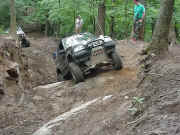
Tracker Nine Inch SuspensionWith Jim Mazzola
After hundreds of e-mails and three redesigns I finally squeezed in the time necessary to document the 9 inch suspension that I’ve designed.
 The new JII series of vehicles from Suzuki hit the shores of the U.S. in 1989 without much fanfare. This new vehicle was to replace the ill fated Samurai which had gotten unmercifully beat up as being unstable and prone to roll overs. The new vehicle incorporated upgraded components (i.e. larger engine) and a more civilized passenger compartment with a real heater and air conditioning! Albeit for one flaw in the mind of serious fourwheelersIndependent Front Suspension (I.F.S.) I.F.S. is a bit of a curse if your not a bona fide suspension and steering geometry engineer. There have only been a few articles written on the subject due to its complexity. There are many obstacles and issues that need to be considered in selecting a commercially available system or, if you’re so adept, designing a suspension system from the ground up. As with any system and certainly an I.F.S. variant, there are a lot of things that interact with each other and all must be addressed simultaneously.
The new JII series of vehicles from Suzuki hit the shores of the U.S. in 1989 without much fanfare. This new vehicle was to replace the ill fated Samurai which had gotten unmercifully beat up as being unstable and prone to roll overs. The new vehicle incorporated upgraded components (i.e. larger engine) and a more civilized passenger compartment with a real heater and air conditioning! Albeit for one flaw in the mind of serious fourwheelersIndependent Front Suspension (I.F.S.) I.F.S. is a bit of a curse if your not a bona fide suspension and steering geometry engineer. There have only been a few articles written on the subject due to its complexity. There are many obstacles and issues that need to be considered in selecting a commercially available system or, if you’re so adept, designing a suspension system from the ground up. As with any system and certainly an I.F.S. variant, there are a lot of things that interact with each other and all must be addressed simultaneously.
As with any project, you have to start out with an objective. Mine was as follows:
- The lift must be able to be bolted to the original chassis with no hacking of cross members or frame. Some slight grinding for clearances would be acceptable.
- Any consumable component, i.e., bushings, brake lines, struts, etc. must be of factory origin to permit replacement and serviceability. This avenue also assures quality components in the kit. I’m not a fan of polyurethane bushings.
- Drive shafts, axle shafts must be factory length. No custom shafts to special order when / if they break.
- Mass is important. Careful attention must be paid to not over design parts.
- Above all it must not lose its drivable characteristics. No buckboard ride, bump steer or any other aspect that would detract from its factory intended comfort.
With all this in mind I set out on designing a lift from the ground up. As a starting point, the x-section in the factory service manual contain some great section views of both front and rear suspensions. I used those and a donated Tracker chassis as a basis to set up the current geometry and to build the new lift. I’ll minimize my talking about the lift and let the pictures do the explaining.
08/11/10 15:25
[tech/footer.htm]
